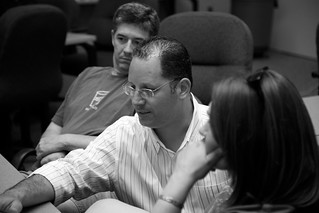A LONG TIME COMING
A while back, Dean and Bud got me thinking. Bud's tweet contains more than a kernel of truth.
Shortly after reading Bud and Dean I was listening to David Suzuki on the radio. He mentioned in passing the idea of "in depth news reports" on television. Generally, that means they're going to talk about an issue for about two minutes. Some issues need to be explored in more depth than that. I think pedagogy is one of those issues. In particular, I think I need to explore my own teaching, articulate my own pedagogical practices, open them up to scrutiny and shore up the weak bits.
George Polya's ideas have been very influential on me and my evolution as an educator. Since reading his Ten Commandments For Teachers I have tried to model them in my practice. Although Polya (1887-1985) is no longer alive, I consider myself one of his students. This series of blog posts is my record of what I'm learning about the craft of teaching.
IN BROAD STROKES
Although I've been thinking about it for a long time, I've got more questions than answers about these commandments. I want to share my thinking and questions here because:
(1) I want to capture my where my thinking is at today so I can come back and reconsider it in the future.
(2) I'm hoping people wiser than I might share some of their insights. I'm hoping the give and take inherent in blogging about it might push my thinking and practice; make me a better teacher.
So push back at any weak bits below or share your own teaching tip.
THE TEN COMMANDMENTS FOR TEACHERS
In chapter 14 of Mathematical Discovery Polya lists his Ten Commandments For Teachers. They have been a guiding light for me as a teacher since I first read them.
1. Be interested in your subject.
2. Know your subject.
3. Know about the ways of learning: The best way to learn anything is to discover it by yourself.
4. Try to read the faces of your students, try to see their expectations and difficulties, put yourself in their place.
5. Give them not only information, but "know-how," attitudes of mind, the habit of methodical work.
6. Let them learn guessing.
7. Let them learn proving.
8. Look out for such features of the problem at hand as may be useful in solving the problems to come — try to disclose the general pattern that lies behind the present concrete situation.
9. Do not give away your whole secret at once — let the students guess before you tell it — let them find out by themselves as much as is feasible.
10. Suggest it, do not force it down their throats.
MODELING PASSION: Be Interested In Your Subject
If you were a student in grade 8, and your teacher began a new unit of study like this what do you think your engagement with the material might be? Passion Based Learning is powerful stuff. There's something magnetic about a teacher who is passionate about what they are teaching. Passion leads to Interest leads to Life Long Learning. Kids need to see that their teachers are interested with their subject and constantly trying to get better at what they do. If we don't model the drive for excellence in what we teach why should they be interested in doing excellent work in our classes?
The teacher's most powerful pedagogical tool in their toolbox is tucked away in their attitude, demeanor and engagement with what they are teaching; we call it modeling. It's such a fundamental idea. Surprisingly, some quick searching on the net reveals very little written about the importance of modeling in education as a general pedagogical practice. Even wikipedia has very little to say about it; the closest article to this idea is called Modelling (psychology). It seems to me we need a few good educators to flesh this article out a bit on wikipedia.
A while back Dean asked, Can A Fat Man Teach Phys. Ed.? His answer: "Yes, but ..." It all comes back to the importance of modeling.
I'm reminded of Benjamin Zander who says:
Our job is to awaken possibility in others ... You know you're doing it when their eyes are shining. And if their eyes are not shinning, then we have to ask ourselves, "Who am I being that my [students] eyes are not shinning?"
Ten Commandments with Hebrew Numbering
Waiting for Time to Pass
The_joy_of_teaching
- 9/06/2009 10:12:00 am
- 10 Comments









